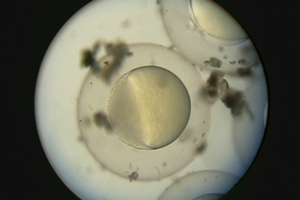Zebra Fish as a Model for Muscle Development
School:
Hereford High School, Maryland, Supervisor of Secondary Science, Baltimore County Public Schools, MarylandLesson Plan Standards
1.1.1 1.1.2 1.1.4 1.2.1 1.2.2 1.2.4 1.2.5 1.2.6 1.2.7 1.3.1 1.3.2 1.3.3 1.3.4 1.4.1 1.4.2 1.4.3 1.4.6 1.4.7 1.4.8 1.4.9 1.5.1 1.5.2 1.5.6 1.5.8 1.5.9 1.6.5 1.7.1 1.7.2 1.7.5 1.7.6 2.1.1 3.1.2 3.2.1 3.2.2 3.3.2 3.3.3 3.3.4 6.4.2Lesson Summary
 Students will learn the steps of protein synthesis and be able to apply these steps to a real-life problem. Students will have the opportunity to use the scientific method to design their own experiment relating to this experience.
Students will learn the steps of protein synthesis and be able to apply these steps to a real-life problem. Students will have the opportunity to use the scientific method to design their own experiment relating to this experience.
Research Experience:
Ms. Baker worked with Dr. Jim Du of the Center of Marine Biotechnology now known as the Institute of Marine and Environmental Technology (IMET) in Baltimore, MD, as part of the ESEP Chesapeake Teacher Research Fellowship (CTRF) during the summer of 2004. The research project concerned “Genetic expression of muscle development in zebrafish". Mr. J. Adam Frederick, served as the CTRF advisor for the Maryland Sea Grant Extension Program.Ms. Baker now serves as Supervisor of Secondary Science Baltimore County Public Schools in Maryland.5E For This Lesson Plan
Engagement
Engagement
This activity captures the students' attention, stimulates their thinking, and helps them to access prior knowledge.
Zebrafish Video Clips
Students will be able to compare and contrast different types of zebrafish in order to identify a problem by observing a video clip and recording observations.
Exploration
Exploration
In this section students are given time to think, plan, investigate, collect and organize information.
Observation and Sequence of Fish Developmental Stages
Students will be able to distinguish between developmental stages of zebrafish as well as compare those stages to humans by directly observing zebrafish embryos and completing a graphic organizer.
Explanation
Explanation
Students are now involved in an analysis of their own explorations. Their understanding is clarified and modified because of the reflective nature of the activities.
Protein Synthesis Simulation
Students will be able to sequence the steps of protein synthesis by manipulating a model, observing a demonstration, and completing a flow chart.
Transition from Explanation to Extension
The muscle gene must be "turned off" in this BOP fish. How can this happen to DNA in nature? How could this be done in the lab?
Extension
Extension
This section gives students an opportunity to expand and solidify their understanding of the concepts and to apply them in a real-world context.
Cancer Research
Students will be able to identify causes, symptoms, and treatments for various types of cancer by making a brochure and doing a presentation.
Evaluation
Evaluation
This performance-based activity helps students to connect all of the pieces of information involved in these lessons.
Design a Zebrafish Experiment
Students will be able to answer how the environment affects development of organisms by designing and conducting an original experiment.





